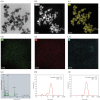Preparation of hybrid particles of Ag nanoparticles and eggshell calcium carbonate and their antimicrobial efficiency against beef-extracted bacteria
- PMID: 37234493
- PMCID: PMC10206469
- DOI: 10.1098/rsos.221197
Preparation of hybrid particles of Ag nanoparticles and eggshell calcium carbonate and their antimicrobial efficiency against beef-extracted bacteria
Abstract
In this study, hybrid particles of AgNPs-loaded eggshell calcium carbonate (AgNPs/eCaCO3) were prepared by co-precipitating the eggshell in the presence of freshly prepared AgNPs with a particle size of 10-30 nm. The hybrid particles were comparatively precipitated at 25°C and 35°C using poly (sodium 4-styrenesulfonate) as a polyelectrolyte. The AgNPs/eCaCO3 particles prepared at 25°C had a spherical morphology with a mean diameter of 3.56 µm, and Brunauer-Emmett-Teller (BET) surface area of 85.08 m2 g-1. On the other hand, the particles prepared at 35°C had a broader size distribution with a mean diameter of 3.19 µm, and a BET surface area of 79.25 m2 g-1. AgNPs-loaded commercial calcium carbonate particles (AgNPs/CaCO3) comparatively prepared at 35°C were perfectly spherical with a mean diameter of 5.61 µm. At preparing temperature of 25°C, the hybrid particles contain AgNPs of 0.78 wt% for AgNPs/eCaCO3 and 3.20 wt% for AgNPs/CaCO3. The AgNPs/eCaCO3 and AgNPs/CaCO3 particles exhibited the same efficiency against bacteria extracted from beef with an average inhibition zone diameter of 7-10 mm according to the modified Kirby-Bauer disc diffusion assay depending on their concentration and beef source. Freshly prepared silver colloids showed comparatively poorer antimicrobial efficiency.
Keywords: antimicrobial agent; co-precipitation; eggshell calcium carbonate; food packaging; silver loaded eggshell calcium carbonate; silver nanoparticles.
© 2023 The Authors.
Conflict of interest statement
We have no competing interests.
Figures












Similar articles
-
Tuning polymorphs of precipitated calcium carbonate from discarded eggshells: effects of polyelectrolyte and salt concentration.RSC Adv. 2022 May 16;12(23):14729-14739. doi: 10.1039/d2ra01673g. eCollection 2022 May 12. RSC Adv. 2022. PMID: 35702206 Free PMC article.
-
Vaterite vectors for the protection, storage and release of silver nanoparticles.J Colloid Interface Sci. 2023 Feb;631(Pt A):165-180. doi: 10.1016/j.jcis.2022.10.094. Epub 2022 Oct 22. J Colloid Interface Sci. 2023. PMID: 36375299
-
Green synthesis of silver nanoparticles using Phlebopus portentosus polysaccharide and their antioxidant, antidiabetic, anticancer, and antimicrobial activities.Int J Biol Macromol. 2024 Jan;254(Pt 1):127579. doi: 10.1016/j.ijbiomac.2023.127579. Epub 2023 Nov 2. Int J Biol Macromol. 2024. PMID: 37918606
-
Size and Aging Effects on Antimicrobial Efficiency of Silver Nanoparticles Coated on Polyamide Fabrics Activated by Atmospheric DBD Plasma.ACS Appl Mater Interfaces. 2015 Jul 1;7(25):13731-44. doi: 10.1021/acsami.5b04340. Epub 2015 Jun 17. ACS Appl Mater Interfaces. 2015. PMID: 26057400
-
Biochemical properties of novel Carbon nanodot-stabilized silver nanoparticles enriched calcium hydroxide endodontic sealer.PLoS One. 2024 Jul 3;19(7):e0303808. doi: 10.1371/journal.pone.0303808. eCollection 2024. PLoS One. 2024. PMID: 38959277 Free PMC article.
Cited by
-
Probing capping mechanisms and polymer matrix loading of biogenic vaterite CaCO3-Ag hybrid through X-ray photoelectron spectroscopy (XPS).RSC Adv. 2024 May 3;14(21):14624-14639. doi: 10.1039/d4ra01710b. eCollection 2024 May 2. RSC Adv. 2024. PMID: 38708108 Free PMC article.
-
Biogenic Vaterite Calcium Carbonate-Silver/Poly(Vinyl Alcohol) Film for Wound Dressing.ACS Omega. 2023 Dec 19;9(1):955-969. doi: 10.1021/acsomega.3c07135. eCollection 2024 Jan 9. ACS Omega. 2023. PMID: 38222591 Free PMC article.
-
Application of the synergism between eggshells and copper in nanotechnology.Nanoscale Adv. 2025 Apr 30;7(13):3914-3940. doi: 10.1039/d5na00400d. eCollection 2025 Jun 24. Nanoscale Adv. 2025. PMID: 40417167 Free PMC article. Review.
References
-
- Chen J, Li S, Luo J, Wang R, Ding W. 2016. Enhancement of the antibacterial activity of silver nanoparticles against phytopathogenic bacterium Ralstonia solanacearum by stabilization. J. Nanomater. 2016, 1-15. (10.1155/2016/7135852) - DOI
-
- Beaudrie CEH, Kandlikar M, Ramachandran G. 2011. Using expert judgment for risk assessment. In Assessing nanoparticle risks to human health, 1st edn (ed. Ramachandran G), pp. 109-138. Norwich, NY: William Andrew Publishing. (10.1016/B978-1-4377-7863-2.00005-4) - DOI
-
- Marambio-Jones C, Hoek EMV. 2010. A review of the antibacterial effects of silver nanomaterials and potential implications for human health and the environment. J. Nanopart. Res. 12, 1531-1551. (10.1007/s11051-010-9900-y) - DOI
Associated data
LinkOut - more resources
Full Text Sources

